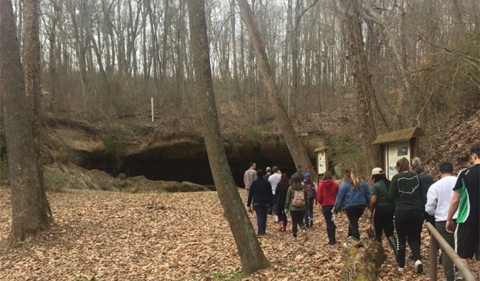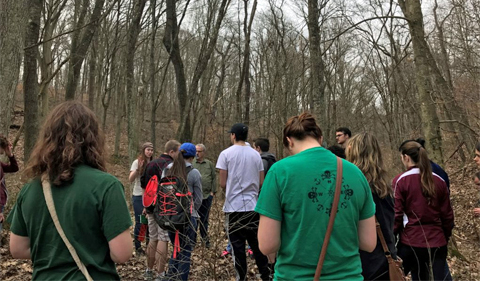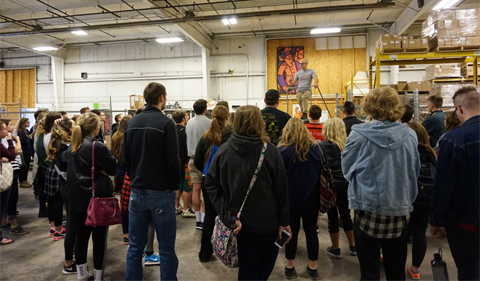
Students walking to Robinson’s Cave. Photo taken by Anthony Cordetti in CAS 2300x
Sixth-six Ohio University students visited notable historic sites critical to understanding Southeast Ohio’s coal-mining roots and history of activism on Saturday, March 25, with the Wealth and Poverty theme.
They include students from CAS 2300x Themes in Action: Wealth and Poverty, HLTH 6760 Environmental Health Sciences in Public Health, POLS 3060 Politics of Appalachia, SOC 2300 Social Inequalities and Social Change, and T3 4400 Seminar in Wealth and Poverty.
 The field trip was led by Dr. Barry Tadlock (Political Science) and Dr. Rachel Terman (Sociology). Dr. Katherine Jellison of History also participated in this trip. Students left with a renewed appreciation of Ohio’s Appalachian history and its profound roots in the labor organizing movement.
The field trip was led by Dr. Barry Tadlock (Political Science) and Dr. Rachel Terman (Sociology). Dr. Katherine Jellison of History also participated in this trip. Students left with a renewed appreciation of Ohio’s Appalachian history and its profound roots in the labor organizing movement.
During the trip, students made stops at the New Straitsville History Museum, downtown Shawnee, Tecumseh Lake and ACENet’s Business Center and Food Hub in Nelsonville.
In New Straitsville, students were greeted by Cheryl Blosser, president of the museum and member of the Little Cities of Black Diamonds group. Blosser described the region’s rich history of forming labor unions such as the Knights of Labor Union Assemblies, which, led by Christopher Evans, carried out the historic Hocking Valley Coal Strike from 1884 to 1885. Students walked to Robinson’s Cave, where it is believed that miners met and spoke before striking underground mine fires. Later, such protests led to the successful formation of the National Federation of Miners, established in New Straitsville, which later merged with competing unions to establish the United Mine Workers of America.

Students listening to John Winnenberg of Sunday Creek Associates. Photo taken by Paige Shoemaker in CAS 2300x.
Later, students met with Sally Sugar of the Buckeye Trail Association and with John Winnenberg, who helped to re-establish the beautiful Tecumseh Theater in downtown Shawnee after the company town was largely abandoned, and the theater left in ruins. Students visited Tecumseh Lake in Wayne National Forest and were taken inside the Tecumseh Theater, built in 1907, where Winnenberg explained Shawnee’s importance, as it was once the largest mining town in the Hocking Valley “coal boom” era.
Prior to returning to Athens, students stopped by ACENet’s Business Center & Food Hub in Nelsonville, where they heard from Ohio University alum Jonathan Milo Leal, founded of Milo’s, which manufacturers “JB’s Sauces” and “Vino de Milo” right in Southeast Ohio, with help from the facilities at ACENet. Students walked away with a gift of JB’s Best mango pineapple salsa.
(This article has been edited from an essay written by a student enrolled in POLS3060 Politics of Appalachia.)



















Comments